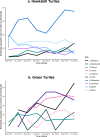A brighter future? Stable and growing sea turtle populations in the Republic of Maldives
- PMID: 37099499
- PMCID: PMC10132635
- DOI: 10.1371/journal.pone.0283973
A brighter future? Stable and growing sea turtle populations in the Republic of Maldives
Abstract
The Indian Ocean represents a significant data gap in the evaluation of sea turtle population status and trends. Like many small island states, the Republic of Maldives has limited baseline data, capacity and resources to gather information on sea turtle abundance, distribution and trends to evaluate their conservation status. We applied a Robust Design methodology to convert opportunistic photographic identification records into estimates of abundance and key demographic parameters for hawksbill sea turtles (Eretmochelys imbricata) and green sea turtles (Chelonia mydas) in the Republic of Maldives. Photographs were collected ad hoc by marine biologists and citizen scientists around the country from May 2016 to November 2019. Across 10 sites in four atolls, we identified 325 unique hawksbill turtles and 291 unique green turtles-where most were juveniles. Our analyses suggest that, even when controlling for survey effort and detectability dynamics, the populations of both species are stable and/or increasing in the short term at many reefs in the Maldives and the country appears to provide excellent habitat for recruiting juvenile turtles of both species. Our results represent one of the first empirical estimations of sea turtle population trends that account for detectability. This approach provides a cost-effective way for small island states in the Global South to evaluate threats to wildlife while accounting for biases inherent in community science data.
Copyright: © 2023 Hudgins et al. This is an open access article distributed under the terms of the Creative Commons Attribution License, which permits unrestricted use, distribution, and reproduction in any medium, provided the original author and source are credited.
Conflict of interest statement
The authors have declared that no competing interests exist.
Figures




Similar articles
-
Evaluation of sea turtle morbidity and mortality within the Indian Ocean from 12 years of data shows high prevalence of ghost net entanglement.PLoS One. 2023 Aug 9;18(8):e0289167. doi: 10.1371/journal.pone.0289167. eCollection 2023. PLoS One. 2023. PMID: 37556405 Free PMC article.
-
Densities and drivers of sea turtle populations across Pacific coral reef ecosystems.PLoS One. 2019 Apr 24;14(4):e0214972. doi: 10.1371/journal.pone.0214972. eCollection 2019. PLoS One. 2019. PMID: 31017916 Free PMC article.
-
First record of hybridization between green Chelonia mydas and hawksbill Eretmochelys imbricata sea turtles in the Southeast Pacific.PeerJ. 2016 Feb 18;4:e1712. doi: 10.7717/peerj.1712. eCollection 2016. PeerJ. 2016. PMID: 26925333 Free PMC article.
-
Newly emerging diseases of marine turtles, especially sea turtle egg fusariosis (SEFT), caused by species in the Fusarium solani complex (FSSC).Mycology. 2020 Jan 7;11(3):184-194. doi: 10.1080/21501203.2019.1710303. Mycology. 2020. PMID: 33062381 Free PMC article. Review.
-
Characterisation of the Gastrointestinal Microbiome of Green Sea Turtles (Chelonia mydas): A Systematic Review.Animals (Basel). 2025 May 29;15(11):1594. doi: 10.3390/ani15111594. Animals (Basel). 2025. PMID: 40509060 Free PMC article. Review.
Cited by
-
Crowdsourcing conservation: unveiling Taiwan's sea turtle foraging grounds, emerging threats, and residency with broad societal engagement.BMC Ecol Evol. 2025 Mar 24;25(1):27. doi: 10.1186/s12862-025-02354-2. BMC Ecol Evol. 2025. PMID: 40128653 Free PMC article.
-
Green and Hawksbill Sea turtles of Eastern Atlantic: New insights into a globally important rookery in the Gulf of Guinea.Ecol Evol. 2024 Mar 18;14(3):e11133. doi: 10.1002/ece3.11133. eCollection 2024 Mar. Ecol Evol. 2024. PMID: 38505183 Free PMC article.
-
Habitat use of loggerhead (Caretta caretta) and green (Chelonia mydas) turtles at the northern limit of their distribution range of the Northwest Pacific Ocean.PLoS One. 2024 Apr 4;19(4):e0290202. doi: 10.1371/journal.pone.0290202. eCollection 2024. PLoS One. 2024. PMID: 38573996 Free PMC article.
-
Evaluation of sea turtle morbidity and mortality within the Indian Ocean from 12 years of data shows high prevalence of ghost net entanglement.PLoS One. 2023 Aug 9;18(8):e0289167. doi: 10.1371/journal.pone.0289167. eCollection 2023. PLoS One. 2023. PMID: 37556405 Free PMC article.
References
-
- Barr C. Current status of trade and legal protection for sea turtles in Indonesia. Mar Turtle Newsl. 2001;54: 4–7.
-
- Sidhar A, Tripathy B, Shanker K. A review of legislation and conservation measures for sea turtles in Orissa, India. Indian Ocean Turtle Newsl. 2005;1: 1–7.
-
- Commonwealth of Australia. Recovery plan for marine turtles in Australia. 2017; 1–146.
-
- Hamann M, Godfrey MH, Seminoff JA, Arthur K, Barata PCR, Bjorndal KA, et al.. Global research priorities for sea turtles: informing management and conservation in the 21st century. Endanger Species Res. 2010;11(3): 245–269.
-
- Rees AF, Alfaro-Shigueto J, Barata PCR, Bjorndal KA, Bolten AB, Bourjea J, et al.. Are we working towards global research priorities for management and conservation of sea turtles? Endanger Species Res. 2016;31: 337–382.
MeSH terms
LinkOut - more resources
Full Text Sources
Miscellaneous

